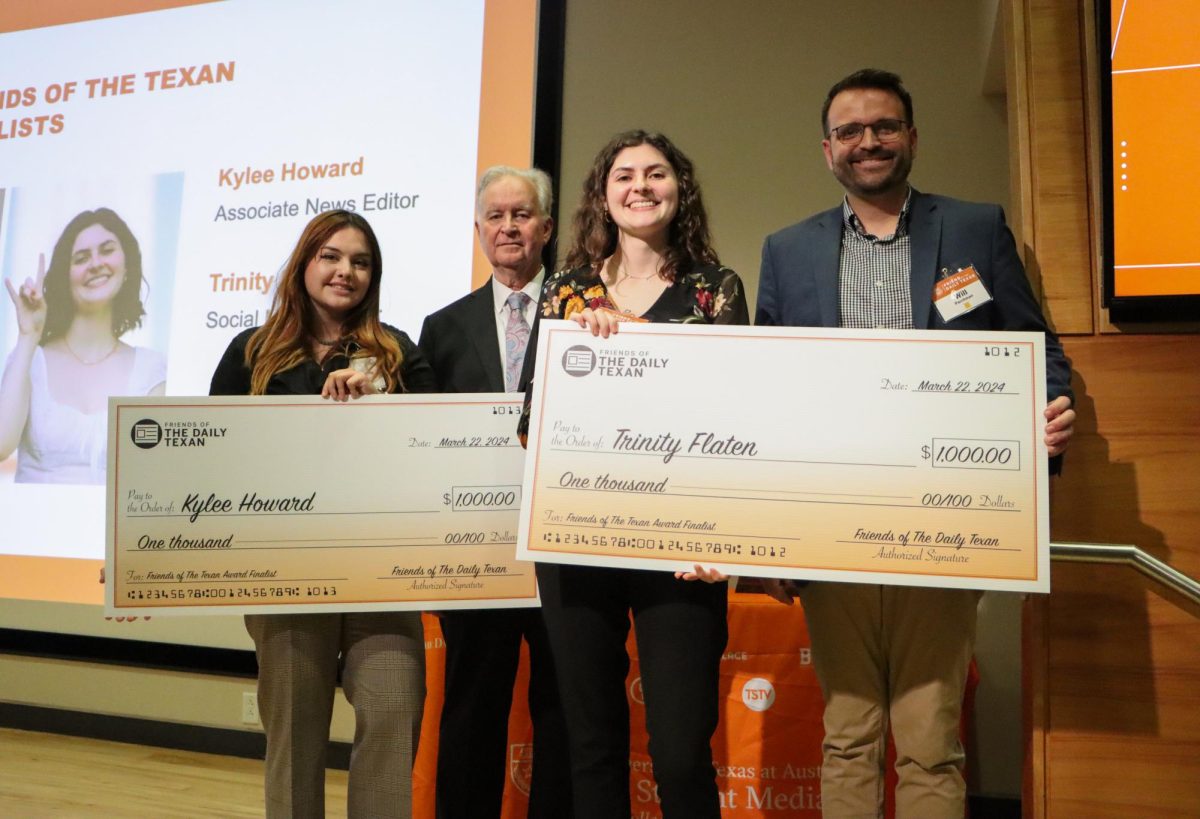
Aaron Torres, a senior in journalism, worked as a senior sportswriter for The Daily Texan last year, and as a general sportswriter covering offseason baseball and softball in fall 2014. He contacted the Friends of The Daily Texan back in the summer when he was reporting on a story for the 50th anniversary of the Tower shooting in 1966. He’s currently interning in the sports department of the Tampa Bay Times, where he’s writing about high school football and some college and professional sports. He will return to school in January and expects to graduate in May. Texan alumna Alicia Dietrich caught up with him recently to ask him about his reporting process and what he’s learned during his time at the Texan.
Tell me about your reporting process for your story about the Tower shooting anniversary.
I pre-reported a little bit, and I tried to find out who the Texan staffers were who were there who were still alive and who were still in the area around Austin who I could talk to. I went online to the PDF version of the Texan from that year, and I looked up everybody who wrote a story on it because I wanted to talk to every Texan staffer who was there. I wanted to recreate that day in a narrative way through the eyes of the Texan staffers.
Then I emailed John Reetz at Friends of The Daily Texan to ask him to send out an email to everyone to get emails or phone numbers for all the Texan staffers who were there that day. From then on, I got a good amount of numbers. I think something like 70 people replied — giving stories about that day or giving contact info for people who were there that day, or sharing their own stories about what that day was like for them.
After I got contact information, I emailed them and told them what I wanted to do and started scheduling interviews. Because it was such a big and important story to me, I wanted to do all the interviews in person. For this story, I felt like over the phone would have been harder, especially since it’s been 50 years since this happened.
John Economidy [then editor in chief of the Texan] was the first person I spoke to. I drove down to San Antonio and talked to him for two hours. Then the next day, I had to go to Houston to cover the Team USA training camp, but [then-sportswriter] Michael Lonsford happens to live in Houston, and so I emailed him and interviewed him on July 12 for about an hour and a half. Then the day I got back from Houston, I had an interview with [then-special sections editor] Sen. Judith Zaffirini at the Capitol, and then I had an interview with [then-managing editor] Virgil Johnson two hours later. That week was very hectic.
How much did you know about the Tower shooting and its history before delving into that project?
I knew a good amount. I’m kind of a history nut. I think the first time I heard about the Tower shooting, I was 13 or 14, and so I read up on it when I was that age. As time went on, I read more about it, and I knew a good bit about what that day was like on a general scale. I didn’t know much about it from the victims’ perspective or about people who were there.
What were the alumni like when you contacted them?
They were actually pretty open. I was glad and pretty surprised that was the case because I know it’s a difficult thing to talk about. To go through a traumatic experience like that and then to talk about reporters about it over and over, I can’t imagine doing it.
As someone who works in the Texan basement now, what was it like hearing stories about being on the front lines of such a horrible day?
I know it made me think about how I would have covered this. What would have happened if there was a shooting now? What would I be doing? How would I react to this? As a journalist, you’re supposed to tell the news. But I know who I am as a person, and I’d be really horrified and really traumatized by it.
I asked all of them, how were you able to cover this? I mean, you’re 21, you’re 22 years old, and you have to deal with — at that point — really the first mass shooting in U.S. history, whereas now it feels like it’s something that happens every other day. You’re really covering something for which there’s no blueprint, no example you can point to — here’s how the Washington Post or New York Times covered this X number of years ago, so here’s what we have to do. I was truly shocked by it.
As I was walking around campus, I was always picturing where they were and what they were doing that day. As a reporter, I don’t know if I would be able to cover something like that. How they were able to do it — it’s astounding to me.
What’s the most important story you’ve written for the Texan?
I wrote two long-form stories about the Tower shooting — one was a narrative of Texan reporters, and one was a 1,200-word story on the Tower shooting memorial. That story was the main story on the front page for the 50th-anniversary edition of the Texan for the Tower shooting.
Our advisor, Peter Chen, said it was a really good story, and for anybody who doesn’t know Peter, he rarely says we do a good job with a story. That’s a joke, but he’s a very harsh critic, which is good for me because I like to be pushed. I was proud that he liked it, that the sources felt I got it right. I was lucky that it was able to be on the front page for that day, which is something I never thought would happen because I’m a sportswriter.
How did you land your fall internship at the Tampa Bay Times?
I was trying to find an internship for the fall and reached out to every publication I could. I think I emailed about 25 editors at publications around the U.S. asking if they had internships in the fall. Tampa was one of the places that did, and they interviewed me and thankfully hired me.
What’s next for you?
I’ll get back to school next semester, graduate and hopefully find a job. I’ll try to intern again at the Statesman in the spring.
I’ll really be trying to find long-form narratives that I can write through immersive reporting when I get back to Austin. I kind of know the journalism I want to do now, so I want to practice as much as I can to write those types of stories, even if I’m not going to get it published. Even if no one’s assigning those stories to me, I still want to write them for practice.
I always thought I wanted to do sports, but now I realize the best stories are about people. Now I’m more attuned to what are the big issues that are happening around Austin and America and how can I write about that issue, or find one person or family or subject that’s emblematic of that issue that I can write about?
How did your time at the Texan help prepare you for life after graduation?
It didn’t just help me for life after graduation. It helped me for life now because since it’s a student newspaper, it helped me try new things and allowed me to gain experience in writing stories in different ways. Sometimes you write two, three stories a week, so you get the repetition, and you’re getting critiqued, so you’re getting better as you go.
The internship I have now — it’s nothing I haven’t experienced before at the Texan. It gives you the experience of what it’s like to be a professional writer in a professional job. Sometimes you have to write a 500-word story in 20 minutes, you have to go to press conferences, you have to go talk to your sources, you have to cover events and then write stories about them. You’re assigned to a beat, and if you’re not writing stories on that beat, then you’re not doing a very good job. It gave me that experience, and now that I have a beat, I know how to do that beat well because I’ve experienced it before.
This interview has been edited and condensed.
Alicia Dietrich is the Director of Public Affairs in the College of Fine Arts at The University of Texas at Austin, and she serves as an officer on the board of The Friends of The Daily Texan. She worked at The Daily Texan from 2002 to 2004 as an Associate Managing Editor, Copy Desk Chief, copy editor, wire editor and features writer.


